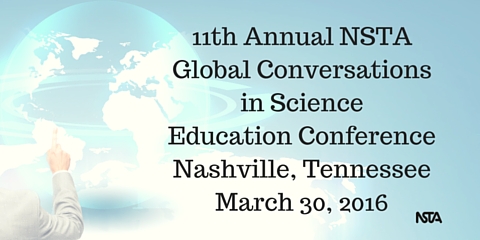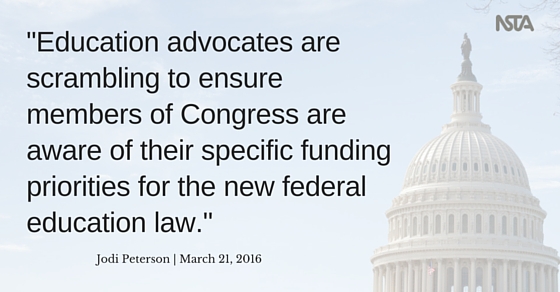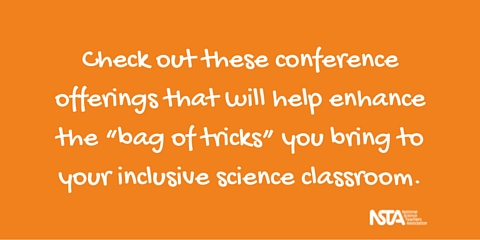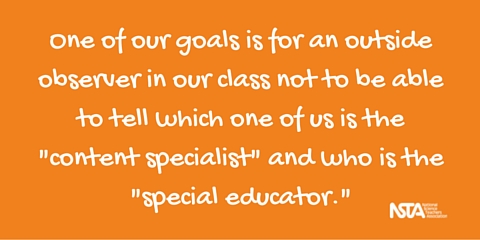Early Childhood at the NSTA 2016 national conference: Elementary Extravaganza and more!
By Peggy Ashbrook
Posted on 2016-03-27
 When I search any conference schedule to choose sessions to attend I am always suspicious of those that are listed as for PreK-12. I am delighted that the NSTA 2016 national conference coming up next week in Nashville has many sessions focused on early childhood years, preschool through grade 2. I will have to make hard choices some days between sessions such as:
When I search any conference schedule to choose sessions to attend I am always suspicious of those that are listed as for PreK-12. I am delighted that the NSTA 2016 national conference coming up next week in Nashville has many sessions focused on early childhood years, preschool through grade 2. I will have to make hard choices some days between sessions such as:
A session by the Council for Elementary Science International, “Building Towers and Structures! Using the Engineering Design Process with Young Children!” and “The Living Classroom: Turning Your Curriculum into an Outdoor Adventure Through Learning Gardens” are both on Thursday, March 31 12:30 PM – 1:00 PM.
On Friday my day will be book-ended by two events for early childhood educators: the Elementary Extravaganza in the morning and an informal gathering from 3:10 PM – 4:30 PM in the lobby of the Omni Nashville Hotel. This gathering brings co-facilitators and members of the NAEYC Early Childhood Science Education interest forum together with all other interested early childhood educators. I hope to meet you there!
 I will also be at the NSTA store to talk with you about my book, Science Learning in the Early Years. The book includes many of the Early Years columns from Science and Children with descriptions of how they can become part of a science inquiry.
I will also be at the NSTA store to talk with you about my book, Science Learning in the Early Years. The book includes many of the Early Years columns from Science and Children with descriptions of how they can become part of a science inquiry.
Don’t miss the Elementary Extravaganza! On Friday, April 1 from 8:00 AM – 10:00 AM, this grand ballroom will be filled with tables staffed by preK to elementary educators with engaging hands-on activities, strategies to excite and encourage your students, and resources for use in your classroom immediately. There will be a preview of the best trade books available, information about award opportunities, contacts with elementary science organizations, door prizes, and coffee. “Walk away with a head full of ideas and arms filled with materials.” Thank you to participating organizations and sponsors of this event!
 On Saturday, April 2, 5:00 PM – 6:00 PM, I will have to miss the session, “We Are Engineers, Too!,” because I will be assisting Dr. Beth Van Meeteren in her session, “Ramps and Pathways: An Integrated STEM Activity.” I love it when presenters upload handouts on the conference site, allowing me to peek into the session even if I can’t actually attend.
On Saturday, April 2, 5:00 PM – 6:00 PM, I will have to miss the session, “We Are Engineers, Too!,” because I will be assisting Dr. Beth Van Meeteren in her session, “Ramps and Pathways: An Integrated STEM Activity.” I love it when presenters upload handouts on the conference site, allowing me to peek into the session even if I can’t actually attend.
Thank you to Conference Committee Leaders Becky Ashe, Conference Chairperson; Margie Hawkins, Program Coordinator; and Tanisha L. Wesby, Local Arrangements Coordinator!
If you can’t get to Nashville, consider attending the 5th Annual STEM Forum & Expo, hosted by NSTA in Denver in July 27–29, 2016 This event has an entire strand focused on Lower Elementary/Early Childhood.
“Students in the lower elementary grades are beginning to understand the world around them and the role they play in it. They are curious and want to make sense of their surroundings. By providing students with inquiry-based experiences in Science, Technology, Engineering, and Mathematics, we can unlock each student’s natural curiosity and help them understand the world in an engaging way. The foundational skills learned and mastered through the integration of STEM during the early years, if done right, will help these students be critical thinkers and makers that can innovate the future they will be a part of. Sessions in this strand will emphasize open-ended and active exploration, play, and investigation of the real world through the lens of NGSS.”
Well said!
NSTA on the International Scene
By Guest Blogger
Posted on 2016-03-21
With the upcoming Global Conversations in Science Education at the NSTA National Conference on Science Education on Wednesday, March 30, 2016, in the Omni Hotel, I am looking forward to reconnecting with the leaders of the Association of Science Education (ASE). I was fortunate to represent NSTA at the ASE Annual Conference held in January at the University of Birmingham. I not only represented and spoke for NSTA at the International Banquet but I also presented a session focusing on the impact of neuroscience research on science teaching. It was a great experience to work with science educators not just from England but other parts of Europe.
The ASE annual conference is very similar to an NSTA annual conference. They had an International Day prior to the start of the conference, several featured speakers, conference strands to help educators plan their schedule, and the ever-popular vendor tent. The conference is held on a university campus when classes are not in session. Having laboratory facilities available was helpful as well as having the large lecture classrooms for featured speakers.
What is Practical Science?
As I attended sessions and interacted with science educators, I noticed that there were a couple of science education language differences. Practical Science was a strand that focused on the hands-on approach to science in the classroom. Initially I thought they were talking about doing experiments to help students obtain the skills needed to study science. But after talking with educators, I learned that practical science (sometimes called practical work) was the place in science instruction where students carry out science. The same questions were being asked there that I often hear asked at NSTA conferences: How do we move from just “hands-on” to include “minds-on” activities? How can we move from “cookbook style” experiences to more open-ended ones? How do students take their learning from the practical science activities to the next level—application? Hearing these questions made me feel at home and I realized that these educators have the same concerns as we do in the United States.
I discovered that both primary and secondary schools hire “school science technicians” to support teachers and pupils directly with practical work. I was a little jealous because it would have been great to have an extra educator to help plan the practical experiences and to make sure that safety was being carried out in the classroom. The Consortium of Local Education Authorities for the Provision of Science Education (aka, CLEAPSS) provides professional development for these technicians as well as science educators. This consortium not only provides resources for the science classrooms but also conducts audits of health and safety in school science departments. Safety is definitely important in UK science classrooms. They are eager to share their resources with U.S. teachers. So, check out the website: www.cleapss.org.uk.
Wicked Problems
My favorite presentation during the conference was “Wicked Problems” by Justin Dillon. I was intrigued by the title, and the speaker did not disappoint. He shared that “wicked problems” are not “evil” problems but problems that are difficult to resolve and not readily addressed by working in disciplinary silos. Working on “wicked problems” is similar to those real-world scenarios we want U.S. students to address. These scenarios are not easily defined from one disciplinary core idea. Solving “wicked problems” will demonstrate to our students that one cannot solve problems in isolation and that teamwork and collaboration are imperative. I applied this presentation to what we want students to do using the Next Generation Science Standards–using science and engineering skills as they learn disciplinary core ideas and apply cross-cutting concepts.
After returning to the U.S., I reflected that these science educators have the same goals as U.S. science educators. First, they are professionals who want to learn about successful strategies that engage all their students in science and STEM. And, second, these educators come together at the conference to learn ways to promote the value of science education in their communities. Overall, these science educators want to make their science classrooms better for their students and they realize the value of attending science education conferences because of the networks they build with other educators.
I encourage NSTA members when given the opportunity to attend a science education conference in another country to do so. You will find a kinship with these educators and build new networks of communication. The NSTA International Advisory Board is a great resource of possible opportunities. Visit their webpage at www.NSTA.org. And if you’ll be attending our conference in Nashville at the end of the month, consider adding the Global Conversations in Science Education miniconference onto your schedule. There will be an international gathering of educators, a poster session, and more. Read the full agenda here.
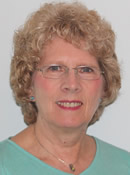 Carolyn Hayes is the NSTA President, 2015–2016; follow her on Twitter at caahayes.
Carolyn Hayes is the NSTA President, 2015–2016; follow her on Twitter at caahayes.
The mission of NSTA is to promote excellence and innovation in science teaching and learning for all.
Future NSTA Conferences
2016 National Conference
2016 STEM Forum & Expo
2016 Area Conferences
Follow NSTA
Legislative Update
FY2017 Funding, ESSA and More
By Jodi Peterson
Posted on 2016-03-21
There has been a lot of activity on Capitol Hill with FY2017 appropriations, the new federal education law ESSA, and at the Department of Education.
The Race is on for FY2017 Appropriations
It’s not clear where and if the political winds will be blowing (and if they will knock out the regular appropriations process for FY2017 programs), but education advocates are scrambling to ensure members of Congress are aware of their specific funding priorities for the new federal education law, the Every Student Succeeds Act.
In a letter to Appropriations leaders, the STEM Education Coalition (which NSTA chairs) is asking Congress to fund ESSA Title II at the authorized level of $2.25 billion, support full funding for Title IV programs at $1.65 billion, fund $10 million for the STEM Master Teacher Corps, and to support the proposal of $100m for the new Computer Science for All. Read the Coalition’s letter to Congress.
NSTA is also part of a new coalition that is seeking full funding ($1.65 billion) for the ESSA Title IV A, Student Support and Academic Enrichment Grants. This flexible block grant, which is authorized at $1.65 billion in FY 2017, authorizes activities in three broad areas:
1) Providing students with a well-rounded education (e.g. college and career counseling, STEM, arts, civics, IB/AP)
2) Supporting safe and healthy students (e.g. comprehensive school mental health, drug and violence prevention, training on trauma-informed practices, health and physical education) and
3) Supporting the effective use of technology (professional development, blended learning, devices).
Specifically, in regards to the use of Title IV A funds for STEM, districts and states can use grant monies to expand high-quality STEM courses; increase access to STEM for underserved and at risk student populations; support the participation of students in STEM nonprofit competitions (such as robotics, science research, invention, mathematics, computer science, and technology competitions); provide hands-on learning opportunities in STEM; integrate other academic subjects, including the arts, into STEM subject programs; create or enhance STEM specialty schools; integrate classroom based and afterschool and informal STEM instruction; and expand environmental education.
The President’s budget request calls for funding of only $500 million for these grants, and suggests the funds should be competitive. Advocates, including NSTA, believe this amount is “grossly inadequate,” and is meeting with appropriators with this message. Read the letter from 75 groups, including NSTA, seeking robust funding for Title IV.
New Resources on Every Student Succeeds Act
The negotiated rulemaking panel for the ESSA will meet the week of March 21 in Washington, DC. Take a look at the agenda, and more about this process.
The U.S. Department of Education released a new ESSA FAQ document that highlights accountability system transitions for states with No Child Left Behind (NCLB) waiver flexibility, and addresses changes to Title I, Title II, and Title III programs.
The National Education Association plans to spend up to $5 million on ESSA implementation. Read more here.
The Council of Chief State School Officers released a guide for states looking to redesign or refine their teacher evaluation systems under the Every Student Succeeds Act.
Because of changes to Title I in ESSA, some states will lose more Title I funding than other states, as much as 1 percent, says Education Week, Read more.
Senate Introduces Bill on Career and Technical Education
The CTE Excellence and Equity Act would provide federal funding through a competitive grant program to support innovative approaches to redesigning the high school experience for students as schools develop curriculum, assess student performance and teach workplace skills through job shadowing, internships and apprenticeships. The bill would amend the Carl D. Perkins Career and Technical Education Act of 2006, which is expected to be considered by the Senate Health, Education, Labor and Pensions Committee this year.
Senate Confirms New Department of Education Secretary
Last week the U.S. Senate voted 49 to 40 to confirm John B. King Jr. as the nation’s education secretary. King has served as acting secretary since Arne Duncan stepped down in December.
During the Senate confirmation hearing, King faced many questions about the Department’s role in implementing ESSA, and the need to balance new state flexibility with the responsibility states now have to address underperforming schools and students.
In related news, Former Education Secretary Arne Duncan has joined the Emerson Collective to help disconnected young adults in Chicago.
Computer Science Advocates Form New Coalition
And finally, a group of business and non-governmental groups, including Amazon, Code.org, Facebook, Google, Hewlett Packard Enterprise, IBM, Microsoft and TechNet, have formed a new coalition in support of computer science. Read more about the Computer Science Education Coalition.
Jodi Peterson is Assistant Executive Director of Legislative Affairs for the National Science Teachers Association (NSTA) and Chair of the STEM Education Coalition. e-mail Peterson at jpeterson@nsta.org; follow her on Twitter at @stemedadvocate.
The mission of NSTA is to promote excellence and innovation in science teaching and learning for all.
Follow NSTA
What Can Science Teachers Learn about Special Needs at the #NSTA16 Nashville Conference?
By Guest Blogger
Posted on 2016-03-18
Heading to NSTA’s National Conference on Science Education in Nashville, March 31–April 3? Are you looking for proven techniques to help ALL students be more successful in your science classroom? Check out these conference offerings that will help enhance the “bag of tricks” you bring to your inclusive science classroom.
Thursday, March 31
- Creation and Evaluation: Sharing STEM Tasks and Student Work. 8:00–8:30, Omni Nashville Hotel, Music Row 4
- Supporting Students with Learning Disabilities in the Middle School Science Classroom. 12:30–1:00, Omni Nashville Hotel, Broadway J
Friday, April 1
- Use Art to Increase Scientific Literacy in Elementary Students with Special Needs. 9:30–10:30, Music Center 106A
- Integrating STEM, STEAM, and Culturally Relevant Teaching into Teacher Preparation Programs to ELLs and Those with Disabilities, 3:30–4:30
Saturday, April 2
- Science Explorations with Deaf and Hard of Hearing Students. 8:00–9:00, Omni Nashville Hotel, Legends G
- Adopting, Adapting, and Applying the 5E Instructional Model to Enhance Science Experiences for Students with Special Needs. 9:30–10:30, Music City Center, 106A
- Science for Everyone! Engaging Science Instruction for Students with Profound Disabilities. 12:30–1:30, Renaissance Nashville Hotel, Fisk One
- Creating a Professional Learning Community to Facilitate Collaboration in Science Inclusion Classrooms. 5:00–6:00, Omni Nashville Hotel, Electric
Coming to Nashville early? Science Education for Students with Disabilities, an associated group with NSTA, is conducting a pre-conference meeting on Wednesday, March 30, from 9:00 to 4:00. For more information contact, Rachel Zimmerman-Brachman at Rachel.zimmerman-brachman@jpl.nasa.gov.
Today’s guest blogger is Melissa Sleeper, NBCT, EA/Science, MAVEN Educator Ambassador, Eighth Grade Science Teacher
This blog is part of a series being published by NSTA’s Special Needs Advisory board, the charge of which is to “Advise NSTA standing committees and NSTA headquarters regarding support for members with special needs and for teachers of students with special needs; make recommendations to the Executive Director and the Board of Directors regarding issues and projects related to special education.” Teresa M. Fulk is the chair of NSTA’s Special Needs Advisory Board and can be contacted with questions about the work NSTA does with this community; e-mail Fulk at fulkt@gcsnc.com.
The mission of NSTA is to promote excellence and innovation in science teaching and learning for all.
Future NSTA Conferences
2016 National Conference
2016 STEM Forum & Expo
2016 Area Conferences
Follow NSTA
Outstanding Co-Teaching Practices for Science Teachers
By Guest Blogger
Posted on 2016-03-18
Approximately 70% of students with disabilities in Virginia are spending 80% of their instructional day in the general education classroom. The most frequently used service delivery model is co-teaching. In the fall of 2014, the Virginia Department of Education launched their Excellence in Co-Teaching Initiative. The goal of the Excellence in Co-teaching Initiative is to design a professional development model of co-teaching that supports successful access to the general education curriculum for students with disabilities while recognizing outstanding co-teaching practices.
I am a Special Education teacher with endorsements in Earth and Environmental Science as well as Special Education. I have been co-teaching in a 9th grade Earth Science class for the last 8 years with the same general education teacher. Over the years, we have developed materials and teaching practices that have enabled all students to be successful in our classes and on state-mandated tests. After an application process, my co-teaching partner and I were fortunate to be selected to participate in the Co-Teaching Initiative, to serve as a co-teaching demonstration site. The demonstration sites showcase the implementation of co-teaching by promoting a collaborative model in which general and special education teachers share responsibility for the achievement of all students in the general education classroom through active co-teaching, collaboration and implementation of inclusive and research-based practices. The selected co-teaching partners assist in enhancing current co-teaching practices of others by modeling best practices in co-teaching during on-site visits, and sharing resources with others.
Co-Teaching in Earth Science has been a career-changing experience. Many school systems use the term collaboration when describing programs or classrooms where a general educator and a special educator teach together. I have been a collaborator, and I prefer to co-teach. We are fortunate that we are both certified in the subject area, and we bring our individual strengths to the classroom. We plan lessons together, and we share the responsibilities for grading and getting materials together for lessons. One of our goals is for an outside observer in our class not to be able to tell which one of us is the “content specialist” and who is the “special educator.” While I am a content specialist, I also design specialized instruction for the students in our co-taught classes who have IEPs. Our building level administration is extremely supportive of co-teaching, and provides us with a common planning time each day. In our high school, we have developed a cohort of co-teachers who are committed to utilizing co-teaching best practices in their classrooms. These practices include parallel teaching, station teaching, alternative teaching, team teaching, and one teach/one support. An example of a co-teaching lesson plan, featuring parallel teaching is attached.
Today’s guest blogger is Maribeth Lowe, M.Ed., NBCT-EN, WMHS Science and Special Education Department, Special Education Department Chair
This blog is part of a series being published by NSTA’s Special Needs Advisory board, the charge of which is to “Advise NSTA standing committees and NSTA headquarters regarding support for members with special needs and for teachers of students with special needs; make recommendations to the Executive Director and the Board of Directors regarding issues and projects related to special education.” Teresa M. Fulk is the chair of the Special Needs Advisory Board and can be contacted with questions about the work NSTA does with this community. e-mail Fulk at fulkt@gcsnc.com.
The mission of NSTA is to promote excellence and innovation in science teaching and learning for all.
Future NSTA Conferences
2016 National Conference
2016 STEM Forum & Expo
2016 Area Conferences
Follow NSTA
Are children wondering about dirt (soil)?
By Peggy Ashbrook
Posted on 2016-03-17
 When children work with soil (or dirt as they most often call it), they rarely question where it comes from. Soil, sky, water…they just are. But when they view soil as one component of a garden, one part of the system for growing plants, they may gain enough experience with it to begin classifying it as “good,” “bad,” “hard,” “wet,” and “dry.” In some regions, children may notice the presence of sand grains and clay. Feeling soil and squeezing it into a “ribbon” in your palm is one way soil scientists notice the properties of soil. When bedrock (the rock that lies under the soil) is visible, children may more easily identify how tiny pieces of rock become soil through the process of erosion. Learning how soil is formed through erosion of rock begins in early childhood with experiences but full understanding is not expected until grade 4 or later (see NGSS performance expectation 4-ESS2 Earth’s Systems). No rush!
When children work with soil (or dirt as they most often call it), they rarely question where it comes from. Soil, sky, water…they just are. But when they view soil as one component of a garden, one part of the system for growing plants, they may gain enough experience with it to begin classifying it as “good,” “bad,” “hard,” “wet,” and “dry.” In some regions, children may notice the presence of sand grains and clay. Feeling soil and squeezing it into a “ribbon” in your palm is one way soil scientists notice the properties of soil. When bedrock (the rock that lies under the soil) is visible, children may more easily identify how tiny pieces of rock become soil through the process of erosion. Learning how soil is formed through erosion of rock begins in early childhood with experiences but full understanding is not expected until grade 4 or later (see NGSS performance expectation 4-ESS2 Earth’s Systems). No rush!
 To easily view the materials that are in soil, put a trowel-ful of it in a clear jar, add water but leave some space at the top, and shake well before letting all the parts settle for several hours or overnight. Put a tightly fitting lid on the jar before having the children shake it! I like to use a jar that is easy for preschoolers to handle, such as a mayonnaise jar. Put tape around the lid to remind children not to open the jar and keep it available for as long as the children are interested. They will return to it over time, shaking and then viewing the results again and again. What will the results be? That depends on the composition of the soil that was put into the jar. There will be some organic matter (bits of dead leaves, roots, maybe an insect or worm), small pebbles, sand, silt (smaller than sand grains but you can still feel them) and clay (very small but you know it when you feel that slick stickiness). These materials will settle out into rough layers, especially when given a long period of settling. Teachers and upper elementary students can follow more detailed directions in the Field Museum’s Underground Adventure webpages. Retired teacher, Moira Whitehouse shared a fifth grade level slide show on soil properties that is useful for teachers to adapt for other ages. The GLOBE Soil Module has background information in a teacher implementation guide for a series of activities. The information can be adapted for your students.
To easily view the materials that are in soil, put a trowel-ful of it in a clear jar, add water but leave some space at the top, and shake well before letting all the parts settle for several hours or overnight. Put a tightly fitting lid on the jar before having the children shake it! I like to use a jar that is easy for preschoolers to handle, such as a mayonnaise jar. Put tape around the lid to remind children not to open the jar and keep it available for as long as the children are interested. They will return to it over time, shaking and then viewing the results again and again. What will the results be? That depends on the composition of the soil that was put into the jar. There will be some organic matter (bits of dead leaves, roots, maybe an insect or worm), small pebbles, sand, silt (smaller than sand grains but you can still feel them) and clay (very small but you know it when you feel that slick stickiness). These materials will settle out into rough layers, especially when given a long period of settling. Teachers and upper elementary students can follow more detailed directions in the Field Museum’s Underground Adventure webpages. Retired teacher, Moira Whitehouse shared a fifth grade level slide show on soil properties that is useful for teachers to adapt for other ages. The GLOBE Soil Module has background information in a teacher implementation guide for a series of activities. The information can be adapted for your students.
“Mud kitchens” are another way for children to explore the properties of soil as they mix soil and water to create confections and concoctions. Muddy Faces offers a download of Jan White’s ebook, Making a Mud Kitchen, with free registration. She writes, “There is little more important in our physical world than earth and water and they are truly intriguing things, especially when they interact.” Imaginative play engages children for long periods of time, allowing time to make observations and discoveries and test out ideas.
 Search the archive of articles and columns in Science and Children to learn more about investigating soil. In “Teaching Through Tradebooks: The Dirt on Soil” (September 2007) columnist Christine Anne Royce suggests books, describes activities for two age ranges and offers these safety guidelines:
Search the archive of articles and columns in Science and Children to learn more about investigating soil. In “Teaching Through Tradebooks: The Dirt on Soil” (September 2007) columnist Christine Anne Royce suggests books, describes activities for two age ranges and offers these safety guidelines:
- Know the source of your soil samples! Soil can be contaminated by pesticides, animal waste, etc.
- Obtain parent/guardian permission before having students work in soil or in compost to inform them of possible allergens (mold/spores, etc), which might affect students with compromised immune systems, allergies, or asthma.
- Have students wear plastic gloves and make sure all open cuts or scratches are covered minimally to prevent infection, and always wash hands with soap and water after working with soil or compost. Wash desktops with mild soap and water where soil activities took place. Do not allow snacks or other food products during soil activities. Don’t keep wet soil more than a day or two. Mold and bacteria spores will grow in it.
- Wear appropriate clothing (long sleeves and pants) and closed-toed shoes or sneakers when working in a compost pile.
- Handle compost materials, wire mesh, stakes, wooden boards with care and caution. Use only nonmercury thermometers.
And of course, always wash hands after working with soil.
 Although organic matter is only a small part of soil, it provides nutrients and helps keep the soil loose with space for air. Building organic matter into garden soil is one reason to compost scraps of fruits and vegetables from the kitchen or classroom snack. In the March 2016 issue of Science and Children I wrote in the Early Years column about how children in one preschool are adding to a minimalist compost pile. Over time they have observed the decomposition of pumpkins and apple peelings into compost. Does your program compost?
Although organic matter is only a small part of soil, it provides nutrients and helps keep the soil loose with space for air. Building organic matter into garden soil is one reason to compost scraps of fruits and vegetables from the kitchen or classroom snack. In the March 2016 issue of Science and Children I wrote in the Early Years column about how children in one preschool are adding to a minimalist compost pile. Over time they have observed the decomposition of pumpkins and apple peelings into compost. Does your program compost?
2014 Winner of the REVERE Award from PreK-12 Learning Group, Association of American Publishers!
“Next time you see a sunset, stop and sit down for a while.”
2014 Winner of the REVERE Award from PreK-12 Learning Group, Association of American Publishers!
“Next time you see a sunset, stop and sit down for a while.”
Chances are that just under a nearby rock, you’ll spot a roly-poly pill bug. Encourage a child to take a close look, and introduce a fascinating creature. Gently pick it up and watch as it rolls into a ball and unrolls to take a walk. This cousin to lobsters and crabs sheds its crusty skin and will tickle your hand with its 14 (count ’em!) wiggly legs.
Chances are that just under a nearby rock, you’ll spot a roly-poly pill bug. Encourage a child to take a close look, and introduce a fascinating creature. Gently pick it up and watch as it rolls into a ball and unrolls to take a walk. This cousin to lobsters and crabs sheds its crusty skin and will tickle your hand with its 14 (count ’em!) wiggly legs.
2014 Winner of the REVERE Award from PreK-12 Learning Group, Association of American Publishers!
“Next time you see a sunset, stop and sit down for a while.”
2014 Winner of the REVERE Award from PreK-12 Learning Group, Association of American Publishers!
“Next time you see a sunset, stop and sit down for a while.”
Gardening: with limitations and some success
By Peggy Ashbrook
Posted on 2016-03-14
When the preschool moved, the new location presented many obstacles to gardening with children:
- Sloping ground.
- Mature trees shading much of the area.
- English ivy covered portions of the available area.
- The play area had not yet been constructed so the choice of “where” could not be made.
I turned to the resources of the early childhood education and science education communities to get some advice.
 The National Science Teachers Association’s Learning Center has wonderful forums for asking and providing advice and information on many topics. It is free to all to register! I posted in the Early Childhood forum with a post title of “Gardening at school with young children” and heard from many of you with ideas for making a successful garden.
The National Science Teachers Association’s Learning Center has wonderful forums for asking and providing advice and information on many topics. It is free to all to register! I posted in the Early Childhood forum with a post title of “Gardening at school with young children” and heard from many of you with ideas for making a successful garden.
 I found beginning instruction and great encouragement in Early Sprouts: Cultivating Healthy Food Choices in Young Children by Karrie Kalich, Dottie Bauer, and Deirdre MdPartlin (2009 Redleaf Press). Reading, “The most important things are a positive attitude and a willingness to try,” and the details about maintaining the garden were motivating. The work of these authors continues at the Early Sprouts Institute.
I found beginning instruction and great encouragement in Early Sprouts: Cultivating Healthy Food Choices in Young Children by Karrie Kalich, Dottie Bauer, and Deirdre MdPartlin (2009 Redleaf Press). Reading, “The most important things are a positive attitude and a willingness to try,” and the details about maintaining the garden were motivating. The work of these authors continues at the Early Sprouts Institute.
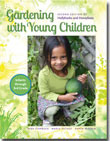 Gardening With Young Children by Sara Starbuck, Marla Olthof, and Karen Midden (2014 Redleaf Press) has supporting information and answers to most of my questions. It was recently reviewed in the Early Childhood Resources Review column in the November 2015 issue of Science and Children (NSTA members can view the review by Gail Laubenthal in the digital version of the journal).
Gardening With Young Children by Sara Starbuck, Marla Olthof, and Karen Midden (2014 Redleaf Press) has supporting information and answers to most of my questions. It was recently reviewed in the Early Childhood Resources Review column in the November 2015 issue of Science and Children (NSTA members can view the review by Gail Laubenthal in the digital version of the journal).
The National Gardening Association published Garden Adventures: Exploring Plants with Young Children by Sarah Pounders (2010), and you can see a KidsGardening.org list of suggested books here.
 The “interim” plan has turned into a long-term plan. We continue with two large pots that nestle next to the fence, in an area that receives about 6 hours of direct sunlight a day, half of it in the afternoon. The successful crops have been a few spinach plants that overwintered without any help from gardeners, and this spring we have a thriving crop of sugar snap peas. We transplanted seedlings grown inside after observing the sprouting seeds. I’m cautiously optimistic that we’ll be able to harvest a handful of pods in late May! It’s a beginning we can grow on.
The “interim” plan has turned into a long-term plan. We continue with two large pots that nestle next to the fence, in an area that receives about 6 hours of direct sunlight a day, half of it in the afternoon. The successful crops have been a few spinach plants that overwintered without any help from gardeners, and this spring we have a thriving crop of sugar snap peas. We transplanted seedlings grown inside after observing the sprouting seeds. I’m cautiously optimistic that we’ll be able to harvest a handful of pods in late May! It’s a beginning we can grow on.
When the preschool moved, the new location presented many obstacles to gardening with children:
- Sloping ground.
- Mature trees shading much of the area.
- English ivy covered portions of the available area.
- The play area had not yet been constructed so the choice of “where” could not be made.
I turned to the resources of the early childhood education and science education communities to get some advice.



